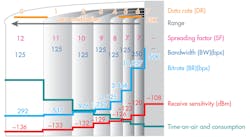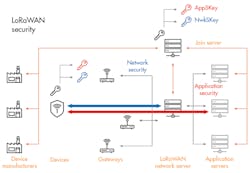Download this article as a .PDF
LoRaWAN stands for long-range wide area network. It is a low-speed, low-power WAN (LPWAN) standard sponsored by the LoRa Alliance. The group recently rolled into Philadelphia to highlight LoRa’s wide area networking support; it has a simple network architecture that does not use repeaters or mesh networking.
Philadelphia was an appropriate venue, as one of the new members to the Alliance is Comcast, whose MachineQ LoRa service covers the city with only three access points. This is just a starting point for Comcast in Philadelphia, as more access points would support more devices and provide wider coverage, but it highlights LoRa’s reach.
LoRa trades off throughput for very-low-power operation and high receive sensitivity (Fig. 1) that translates into long distance support typically measured in kilometers. It fills a niche between other wireless technologies like Bluetooth and Wi-Fi, as well as mesh systems like ZigBee and Z-Wave.
The technology was developed by Semtech. It uses chirped-FM modulation (Fig. 2), where symbols are implemented using ramping frequencies. The higher receive sensitivity allows for long-range operation, as well as better operation through barriers such as walls, but at the expense of throughput. This makes it suitable for many Internet of Things (IoT) applications, but not all. For example, LoRa would not be a good choice for streaming multimedia especially video because of the low throughput. On the other hand, LoRa is ideal for sensor applications where small amounts of data are sent with a long cycle time. This would allow a system to handle a large number of devices.
LoRa uses unlicensed spectrum that differs from country-to-country. In North America, the 915 MHz band is used with 64 upstream channels and eight downstream channels. There are eight additional upstream channels.
LoRa uses 802.15.4’s security mechanism that utilizes 128-bit AES encryption. LoRa also uses a Network Session key and an Application Session key (Fig. 3). The former is used for communication within a LoRa network for managing the connection. The latter is used for exchanging data between an application running on a device and a server application running in the cloud. This means that application data can be sent over any LoRa network without revealing its contents to the carrier. It makes multi-tenant LoRa networks easy to build and manage from a security standpoint.
LoRa gateways are very simple because they forward all incoming packets to a network server, that may be located the cloud, and broadcast any outgoing packets they receive from the server. The gateway packets include data received from a device, along with metadata that includes the reception quality. A data packet from a device may be received by more than one gateway and it is up to the server to handle this. The server must also determine which gateway will send any response to the device. The gateways do not have to encrypt or decrypt information, also simplifying their implementation.
Multiple LoRa networks can operate in the same space. Gateways simply ignore device data packets from other networks. Likewise, a device ignores data destined for other devices. The system supports broadcast operation as well as firmware over-the-air (FOTA) updates, albeit at slow speeds. The update mechanism uses redundant packets with forward error correction that allows some data loss without causing an update failure.
LoRa is a very open standard that allows compatible devices, gateways, and servers to operate together. There are competing systems such as Narrowband IoT (NB-IoT) and proprietary platforms like SigFox. These have applications in a wide range of IoT environments, from smart cities with LoRa sensors embedded in parking spaces to smart agriculture with sensors spread across farms. While it isn’t suitable for all networking chores, it is well positioned for low-speed, long-cycle-time applications that can benefit from its low power requirements, high receive sensitivity and long-range support.
About the Author
William G. Wong
Senior Content Director - Electronic Design and Microwaves & RF
I am Editor of Electronic Design focusing on embedded, software, and systems. As Senior Content Director, I also manage Microwaves & RF and I work with a great team of editors to provide engineers, programmers, developers and technical managers with interesting and useful articles and videos on a regular basis. Check out our free newsletters to see the latest content.
You can send press releases for new products for possible coverage on the website. I am also interested in receiving contributed articles for publishing on our website. Use our template and send to me along with a signed release form.
Check out my blog, AltEmbedded on Electronic Design, as well as his latest articles on this site that are listed below.
You can visit my social media via these links:
- AltEmbedded on Electronic Design
- Bill Wong on Facebook
- @AltEmbedded on Twitter
- Bill Wong on LinkedIn
I earned a Bachelor of Electrical Engineering at the Georgia Institute of Technology and a Masters in Computer Science from Rutgers University. I still do a bit of programming using everything from C and C++ to Rust and Ada/SPARK. I do a bit of PHP programming for Drupal websites. I have posted a few Drupal modules.
I still get a hand on software and electronic hardware. Some of this can be found on our Kit Close-Up video series. You can also see me on many of our TechXchange Talk videos. I am interested in a range of projects from robotics to artificial intelligence.





